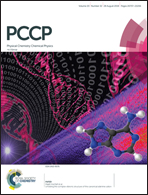Theoretical study of the adsorption of hydrogen on cobalt clusters
Abstract
Adsorption and dissociation of molecular hydrogen on transition metal clusters are basic processes of broad technological application in fields such as catalysis, hydrogenation reactions, hydrogen fuel cells, hydrogen storage, etc. Here we focus on two cobalt clusters, Co6 and Co13, and use the density functional formalism to investigate: (i) the mechanisms for adsorption and dissociation of hydrogen, and (ii) the competition between the two processes as the amount of hydrogen increases towards cluster saturation. The dissociative adsorption of hydrogen is the preferred adsorption channel for low coverage. Each individual H atom binds to the cluster with an ionic type of bonding, similar to that in metal hydrides. The electronic levels of the H atoms hybridize with the deepest levels of the Co cluster, leading to the stabilization of the system. In contrast H2 binds to the cluster with a weak covalent type of bond and the electronic density of the molecule becomes polarized. The electronic levels of the molecule are deeper than those of the Co cluster and do not hybridize with them, which explains the weak bonding of the molecule to the cluster. Interestingly, the high magnetic moments of the Co clusters do not change when H2 is adsorbed in molecular form, but the magnetic moments decrease by two Bohr magnetons upon dissociative adsorption of the molecule. Adsorption and dissociation of H2 on Co6 and Co13 exhibit similar features, although the adsorption energies on Co13 are stronger. Saturation of Co6 with hydrogen has been also investigated. Co6 can adsorb up to four H2 molecules in the dissociated form. Additional hydrogen is adsorbed in molecular form leading to a saturated cluster with sixteen hydrogen molecules, four dissociated and twelve molecular. This limit corresponds to a content of 8.4 wt% of hydrogen in the Co cluster, which is promising for the purpose of hydrogen storage.



 Please wait while we load your content...
Please wait while we load your content...